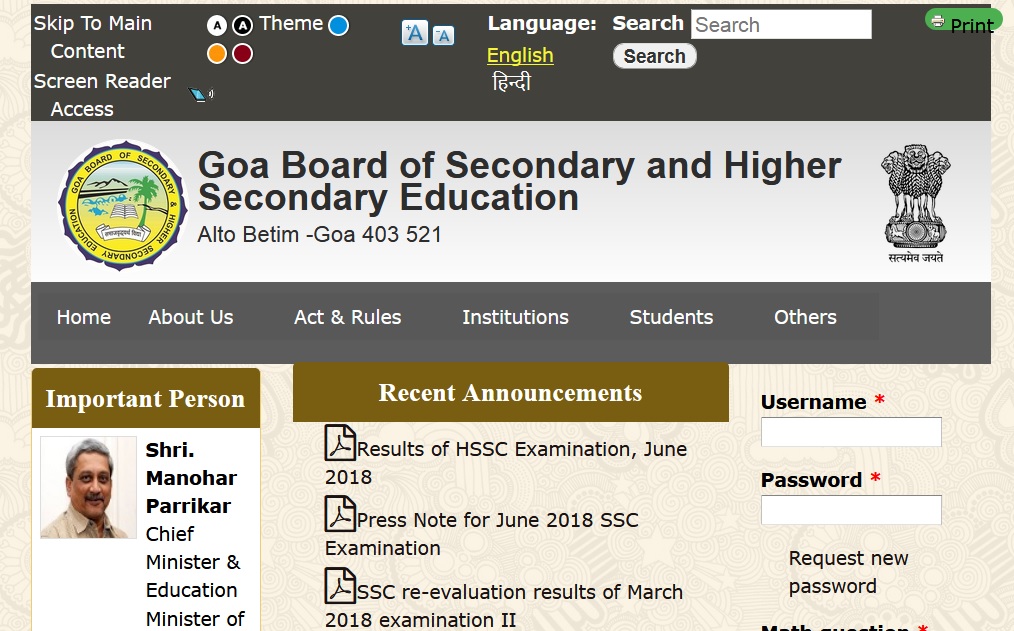gbshse.gov.in : HSSC Psychology Question Paper Model Goa Board Of Secondary & Higher Secondary Education
Board : Goa Board Of Secondary & Higher Secondary Education
Subject : HSSC Psychology
Document type : Model Question Paper
Website : gbshse.gov.in
Download Sample/Model Question Papers :https://www.pdfquestion.in/uploads/5873-model_psycho.pdf
GBSHSE HSSCE Psychology Question Paper
effective from March 2015
MODEL QUESTION PAPER
Time : 2½ hrs Max Marks: 80
Instructions
(1) Answer each question on a fresh page.
Related : Goa Board Of Secondary & Higher Secondary Education HSSC Mathematics Question Paper Model : www.pdfquestion.in/5870.html
(2) Write the number of each question and sub-question clearly.
(3) All questions are compulsory.
(4) Figures to the right indicate marks allotted to each question.
(5) There is no overall choice. However internal choice is provided in Question No. 2 (D) Q, No. 5 (D) and Q. No. 6 (D).
(6) ‘A’ part of every question is a multiple choice question, ‘B’ part of every question should be answered in about 30 words, ‘C’ part in about 60 words and ‘D’ part in about in about 100 words.

Sample Questions
1. (A) An Individual’s preference for engaging in one or more specific activities relative to others is ……………………………….. [1]
** Aptitude
** Interest
** Personality
** Values
(B)State two characteristics of Individual tests. [2]
(C) Explain three facets of intelligence in the Indian tradition. [3]
(D) Explain intelligence as a product of heredity. [4]
2. (A) When people attribute their own traits to others, the Defence Mechanism used is ………………………………… [1]
** Projection
** Repression
** Rationalisation
** Reaction Formation
(B) Explain Halo Effect as a limitation of the method of rating. [2]
(C) Analyse the levels of consciousness given by Freud. [3]
(D) Discuss the features of the Rorschach Inkblot Test. [4]
OR
Discuss Adler’s and Erikson’s approach to Personality.
3. (A) Assistance involving material aid, such as money is a form of …………………. [1]
** Informational support
** Tangible support
** Emotional support
** Positive support
(B) Explain the Behavioural Effects of stress. [2]
(C) Explain three sources of psychological stress. [3]
(D) Analyse Biofeedback and Creative Visualisation as stress management techniques. (4)
4. (A) Perceptions that occur in the absence of external stimuli are called …………………….. [1]
** Delusions
** Hallucinations
** Inappropriate Affect
** Formal thought disorders
(B) State the symptoms of Panic Disorders. [2]
(C) Analyse heroin abuse and dependence. [3]
(D) Explain obsessive-compulsive disorder. [4]
5. (A) The client centered therapy was given by …………………………….. [1]
** Albert Ellis
** Carl Rogers
** Sigmund Freud
** Freiderick Perls
(B) Draw a neat labelled diagram of the Communication Process. [2]
(C) Explain Participant Observation. [3]
(D) Analyse the Rehabilitation of the Mentally Ill. [4]
OR
Analyse the Cognitive Behaviour Therapy.
6. (A) When the information presented first has a stronger effect than the information presented at the end, it is called ……………………….. [1]
** Halo effect
** Primacy effect
** Recency effect
** Secondary effect
(B) Explain ‘Kernel of Truth’ as a source of prejudice. [2]
(C) Discuss the three social norms of pro-social behaviour. [3]
(D) Analyse the following processes of Attitude Formation [4]
i) Learning attitudes by association
ii) Learning attitudes through modelling
OR
Analyse the following methods of Social Facilitation
i) Evaluation apprehension
ii) Nature of the task
7. (A) Togetherness, binding, or mutual attraction among group members is called …………………………… [1]
** Group think
** Group polarisation
** Social facilitation
** Cohesiveness
(B) State two points of difference between Groups and Teams. (2)
(C) Discuss ’Negotiations’ as a conflict resolution strategy. (3)
(D) Discuss Deutsch’s investigation on cooperation and competition within groups. (4)
8. (A) The study of the relationship between living beings and their environment is called ……………………….. (1)
** Minimalist perspective
** Ecology
** Built environment
** Natural environment
(B) State the features of crowding. (2)
(C) Discuss the adverse effects of poverty and deprivation on ‘Personality’. (3)
(D) Discuss the strategies of reducing aggression and violence.
Question Paper Pattern
Class : XII
Time : 2 ½ Hrs.
Subject : Psychology
Max Marks : 80
The weightage or the distribution of marks over different dimensions of the question paper shall be as follows
1. Weightage to Learning Outcomes :
S.No.| Learning Outcomes | Marks | Percentage of Marks
1 Knowledge 24 30%
2 Understanding 34 42.5%
3 Application & Analysis 20 25%
4 Skill 02 2.5%
Total : 80 100%
2. Weightage to Content / Subject Units :
S.No. | Units | Marks
1 Variations in Psychological Attributes 10
2 Self and Personality 10
3 Meeting Life Challenges 10
4 Psychological Disorders 10
5 Therapeutic Approaches and Developing Psychological Skills 10
6 Attitude and Social Cognition 10
7 Social Influence and Group Processes 10
8 Psychology and Life 10
Total : 80
3. Weightage to Forms of Questions :
1 Long Answer Type (LA) 04 08 32
2 Short Answer Type ( SA – I ) 02 08 16
3 Short Answer Type ( SA – II) 03 08 24
4 Very Short Answer Type ( VSA) 01 08 08
Total 10 32 80